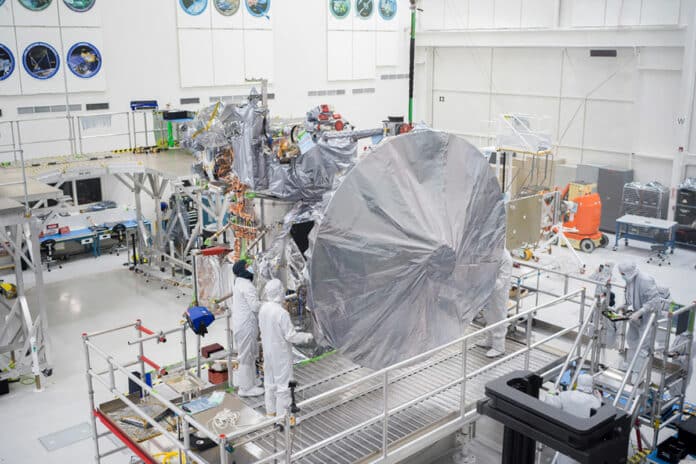Europa Clipper is NASA’s mission to explore Jupiter’s moon Europa and seek out conditions suitable for life on an ice-covered moon of Jupiter. It is scheduled to launch in October 2024.
The agency’s Europa Clipper spacecraft has recently been outfitted with the massive dish-shaped high-gain antenna that will enable it to communicate with mission controllers hundreds of millions of miles away.
The 10-foot (3-meter) high-gain antenna is the largest and most prominent of a suite of antennas on Europa Clipper. The spacecraft will need it to investigate the ice-cloaked moon, some 444 million miles (715 million kilometers) from Earth. The goal of the mission is to learn more about the moon’s subsurface ocean, which might harbor a habitable environment.
Once the spacecraft reaches Jupiter, the antenna’s radio beam will be narrowly directed toward Earth. High-gain antennas are designed to create narrow, concentrated beams by focusing their power, allowing the spacecraft to transmit high-powered signals back to Nasa’s Deep Space Network on Earth.
The precision-engineered dish was attached to the spacecraft in carefully choreographed stages over the course of several hours in a Spacecraft Assembly Facility bay at NASA‘s Jet Propulsion Laboratory in Southern California.
“The antenna has successfully completed all of its stand-alone testing,” said Matthew Bray a few days before the antenna was installed. “As the spacecraft completes its final testing, radio signals will be looped back through the antenna via a special cap, verifying that the telecom signal paths are functional.”
The spacecraft will fly by the moon about 50 times while its science instruments gather data on the moon’s atmosphere, surface, and interior. The spacecraft will train nine science instruments on Europa, all producing large amounts of rich data.
This data includes high-resolution color and stereo images to study its geology and surface; thermal images in infrared light to find warmer areas where water could be near the surface; reflected infrared light to map ices, salts, and organics; and ultraviolet light readings to help determine the makeup of atmospheric gases and surface materials.
The high-gain antenna will stream most of that data back to Earth over the course of 33 to 52 minutes.
After completing this major milestone, Europa Clipper still has a few more steps and a few more tests ahead as it’s prepared for its trip to the outer solar system.
